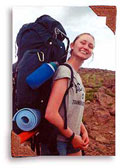
Packing
A Comfortable Pack
By: Eric
Osterling
 Since
you have to have a backpack, why not make carying it the
least of your worries? Use the following tricks to tame
your pack so it's more comfortable and user-friendly while
on the trail.
Since
you have to have a backpack, why not make carying it the
least of your worries? Use the following tricks to tame
your pack so it's more comfortable and user-friendly while
on the trail.
 Stop
Lid Flop:
Stop
Lid Flop:
Pack lids are often heavy with small dense items, and
can flop around annoyingly when your pack is nearly empty
- such as when you've set up camp and are gamboling about
with a few items in your full-size pack. The same flopping
can happen when you've donned most of the extra clothing
in your daypack, too. Even if you really cinch down the
lid straps, the annoying movement often continues - and
the lid can be pulled too low in the process.
Here's
a quick, easy solution:
Drop the lid down inside the pack and simply tighten
the drawstring. This effectively prevents the lid from
flopping around - and it's even easier to get into the
pack bag than when the straps must be undone.
 Fight
Gravity's Drag:
Fight
Gravity's Drag:
Murphy's Law of the Inconvenient Migration of Stuff means
that dense items (especially waterbottles, hydration systems,
large cameras, and fuel) tend to gravitate to the bottom
of your pack, especially when the pack is not full and
tightly packed. Those are precisely the items that often
need to be handy and whose weight should be up high and
close to your back between your shoulder blades for easy
carrying.
Here's
a simple solution:
Suspend a stuffbag to form a pocket inside the pack
at an appropriate height. Attach it with safety pins to
the strong internal seam that encircles the top of most
packs. That way the pins do not pass through to the outside
skin of the pack, and it's usually easy to push the pins
through just the binding tape on the seam.
If you use a waterproof stuff sack, such as Outdoor Research
Hydroseal bags (various sizes and prices, www.orgear.com),
you have extra protection against a leaking bottle or
hydration system wetting the pack contents. Just don't
put the camera in with the water bottle!
 Avoiding
Hip Pain:
Avoiding
Hip Pain:
Button tabs on your pant waistband can convert even the
best of pack hipbelts into a torture instrument. The buttons
are often at the place of greatest hip belt pressure and
are ground into your flesh by the belt. Luckily you can
eliminate most of the problem quite simply:
Stitch the tabs down in the correct position and cut off
the buttons. Or, consider purchasing one of the backpacking-specific
trail pants now on the market, like Mountain Hardwear's
Pack Pants, which feature smooth, seam-free and button-free
waistbands.
 Stoping
"Wet Back" Problems:
Stoping
"Wet Back" Problems:
Sweaty backs are a slimy, smelly downside of backpacking,
especially in the warm summer weather. Your back gets
drenched with sweat, and when you take the pack off at
the end of the day there's an unpleasant chill and clamminess
as all of that moisture in your clothes evaporates. Venting
mesh back panels on the pack help, but when the pack suspension
is lined only with plain fabric over smooth foam panels
you just have to suffer.
Here's
a simple solution:
*Wear
a next-to-skin layer made of a synthetic fabric that doesn't
hold much moisture, and place a piece of cotton towel
between it and your pack. The absorbent cotton pulls the
sweat through the synthetic, which then stays relatively
dry. You won't be any cooler, but at least the sweaty
feel will be diminished, and your skin will be healthier
on a long trip.
*Tie the towel to the pack
as shown in the photo. Avoid having a lumpy hem across
your back by choosing a piece of towel with a fuzzy edge
- or just cut the hem off and put up with a bit of fraying.
*The top edge should be high
on the shoulder blades where there is less pressure anyway.
*Replace the piece of towel
when it becomes drenched, using the identical one you
have hung elsewhere on your pack to dry. In the sun, dark
colors dry fastest.
 Bag-it
To Keep Things Dry:
Bag-it
To Keep Things Dry:
Lining a top-loading pack with a large plastic bag is
an effective way to keep gear dry in wet weather. The
bag repels rainwater seeping in via seams and zippers
in the packbag, and the one-big-bag method occupies less
precious pack space than stuffing gear into lots of small
bags, each of which will probably be somewhat inflated
with air. Good as this method is, it can be made better
with a few refinements:
*Use an orange bag rather
than a dark green or black one - it'll be easier to see
what's in the pack. Also, the high visibility of an orange
bag can make it a very useful item in an emergency.
*Seal by just twisting the
top into a"rope," and tucking the end down between
bag and pack to stop it unwinding. This will suffice in
rain.
*For serious creek crossings,
tie the top of the bag with a piece of cord or your spare
bootlace to create a better seal. If the unthinkable happens,
your pack will then float almost indefinitely, and your
gear will stay dry.
>>
Rate and Review This Article
 For
more information please refer to the High
Sierra Topix message board.
For
more information please refer to the High
Sierra Topix message board.
